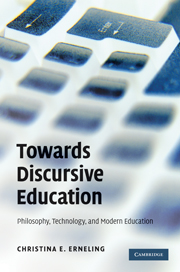Book contents
- Frontmatter
- Contents
- Acknowledgements
- Introduction
- 1 The infantilisation of learning
- 2 Educational technologies and pedagogy
- 3 Piaget and natural learning
- 4 Piaget's conception of the framework: from instincts to intentionality
- 5 The infant as scientist
- 6 The socio-cultural approach to learning
- 7 Towards discursive education
- Appendix
- References
- Index
2 - Educational technologies and pedagogy
Published online by Cambridge University Press: 05 June 2012
- Frontmatter
- Contents
- Acknowledgements
- Introduction
- 1 The infantilisation of learning
- 2 Educational technologies and pedagogy
- 3 Piaget and natural learning
- 4 Piaget's conception of the framework: from instincts to intentionality
- 5 The infant as scientist
- 6 The socio-cultural approach to learning
- 7 Towards discursive education
- Appendix
- References
- Index
Summary
EDUCATIONAL TECHNOLOGIES AND COMPUTERS
The reasons for introducing computers into schools are, of course, many and varied: There is the social rationale that it is important for every child in a modern society to be able to handle a computer, e-mail, and the Internet. There is the related vocational rationale that schools have to prepare pupils for computerised jobs. There is the IT-industry rationale of building markets of future consumers. There is also the cost–benefit rationale that computers are cheap replacements for expensive teachers, and perhaps even facilitate the closing of costly school buildings. One also finds what one could call the catalyst rationale, that is, that computers are revolutionising society, the school, and even the pupil's cognitive abilities. Finally, and of signal importance, there is the pedagogical rationale of improving learning. The pedagogical discussions start to appear in the 1980s, but it is only during the 1990s that they really increase. This is not surprising, since the technology is still relatively new, expensive, and untried. It is during times of relative controversy that one finds both the justifications and the criticism. Prior to this there is too little of interest to engage scholars. Once the technology has become widespread, it becomes less problematic and less in need of justification. Thus my focus is on the years 1990 to 1999.
- Type
- Chapter
- Information
- Towards Discursive EducationPhilosophy, Technology, and Modern Education, pp. 40 - 66Publisher: Cambridge University PressPrint publication year: 2010



